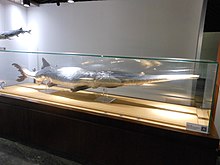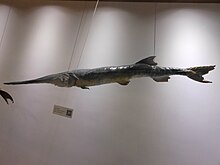Chinese paddlefish: Difference between revisions
Davide King (talk | contribs) m ce |
Added an extinction date of 2019 to the infobox as that is when the assessment was completed, if this is inaccurate and should be changed to the declaration date of 2022; feel free to change it! Tags: Reverted Visual edit |
||
| Line 9: | Line 9: | ||
| status_ref = <ref name="iucn status 21 July 2022">{{cite iucn |author= Qiwei, W. |date=2022 |title=''Psephurus gladius'' |volume=2022 |page=e.T18428A146104283 |doi=10.2305/IUCN.UK.2022-2.RLTS.T18428A146104283.en |access-date=21 July 2022}}</ref> |
| status_ref = <ref name="iucn status 21 July 2022">{{cite iucn |author= Qiwei, W. |date=2022 |title=''Psephurus gladius'' |volume=2022 |page=e.T18428A146104283 |doi=10.2305/IUCN.UK.2022-2.RLTS.T18428A146104283.en |access-date=21 July 2022}}</ref> |
||
| taxon = Psephurus gladius |
| taxon = Psephurus gladius |
||
| extinct = |
| extinct = 2019 |
||
| authority = ([[Eduard von Martens|von Martens]], 1862) |
| authority = ([[Eduard von Martens|von Martens]], 1862) |
||
| parent_authority = [[Albert C. L. G. Günther|Günther]], 1873 |
| parent_authority = [[Albert C. L. G. Günther|Günther]], 1873 |
||
Revision as of 20:47, 22 July 2022
| Chinese paddlefish | |
|---|---|

| |
| Preserved specimens at Museum of Hydrobiological Sciences, Wuhan Institute of Hydrobiology | |
| Scientific classification | |
| Domain: | Eukaryota |
| Kingdom: | Animalia |
| Phylum: | Chordata |
| Class: | Actinopterygii |
| Order: | Acipenseriformes |
| Family: | Polyodontidae |
| Genus: | †Psephurus Günther, 1873 |
| Species: | †P. gladius
|
| Binomial name | |
| †Psephurus gladius (von Martens, 1862)
| |
| Synonyms[2][3] | |
| |
The Chinese paddlefish (Psephurus gladius) (simplified Chinese: 白鲟; traditional Chinese: 白鱘; pinyin: báixún), also known as Chinese swordfish, is an extinct species of fish that was formerly native to the Yangtze and Yellow River basins in China. With records of specimens over 3 metres (9.8 feet) and possibly 7 metres (23 feet) in length, it was one of the largest species of freshwater fish. It was the only species in the genus Psephurus and one of two recent species in the paddlefish family (Polyodontidae), the other being the American paddlefish (Polyodon spathula). It was an anadromous species, meaning that it spent part of its adult life at sea, while migrating upriver to spawn.
The Chinese paddlefish was officially declared extinct in 2022, with an estimated time of extinction to be by 2005, and no later than 2010, although it had become functionally extinct by 1993.[4][5] The main cause of its decline was the construction of the Gezhouba and Three Gorges dams, causing population fragmentation and blocking the anadromous spawning migration. Overfishing also played a significant role in its demise. Fishing of the Chinese paddlefish dates back centuries, with annual harvests reaching 25 tons by the 1970s. Since the 1990s, the species was officially listed by the International Union for Conservation of Nature (IUCN) as critically endangered, and was last seen alive in 2003. A 2019 paper including scientists from the Yangtze River Fisheries Research Institute found the species to be extinct.[5] It was unanimously agreed to be extinct by the Species Survival Commission Sturgeon Specialist Group of the IUCN on 15 September 2019.[6] It was formally listed as extinct by the IUCN in July 2022.[7]
Description

The Chinese paddlefish had a white underbelly, and its back and head were grey.[8] Its dorsal and anal fins were situated considerably far back on the body. The paddle was narrow and pointed, and could reach one third of total body length.[9] Its eyes were small and round.[8] The teeth were noted to be small, and the jaw to be protrusible, unlike the American paddlefish. The tail fin was heterocercal, with a well developed caudal lobe.[9] Like the American paddlefish the skeleton was cartilaginous.[10] The body lacked scales[8], except for small scales in the caudal peduncle and caudal fin.[9] It reached sexual maturity at a weight of around 25 kg (55 lb).[9] Some reports have suggested that the Chinese paddlefish could reach 7 m (23 ft) in length and weigh up to 500 kg (1,100 lb), but these measurements are considered doubtful. A more generally accepted maximum size is 300 kg (660 lb) in weight and 3 m (10 ft) in length.[11]
Taxonomy and evolutionary history

The species was first named as a species of Polyodon by Eduard von Martens in 1862.[12] It was placed into a separate, monotypic genus by Albert Günther in 1873.[13] The species was also given a different name, Spatularia angustifolium by Johann Jakob Kaup also in 1862,[14] but this is considered a junior synonym of P. gladius.[9] Paddlefish (Polyodontidae) are only one of two living families of Acipenseriformes alongside sturgeons (Acipenseridae). The oldest records of Acipenseriformes date to the Early Jurassic, over 190 million years ago. The oldest paddlefish fossil is that of Protopsephurus, known from the Early Cretaceous of China, dating to around 120 million years ago.[15] A 2007 molecular clock analysis suggested that the ancestors of the Chinese paddlefish and American paddlefish diverged approximately 68 million years ago.[16]
Distribution, habitat and ecology

The Chinese paddlefish was native to the Yangtze (Chang Jiang) River basin and its estuary at the East China Sea. Historically it was also recorded in Yellow River basin (which is connected to the Yangtze by the Grand Canal) and its estuary at the Yellow Sea.[9][17][18]

The species spent part of its life in the lower section of the Yangtze, including the brackish water of its estuary, but migrated up river and into major tributaries to spawn, which occurred in Spring, from mid-March to early April.[4] It primarily inhabited the large rivers, but sometimes travelled into large lakes.[4] Due to their anadromous nature, mature individuals were found in coastal waters of the East China Sea and the Yellow Sea, occasionally spring tides would bring individuals into the lower reaches of the Qiantang and Yangjian rivers of Zhejiang province.[19]

The fish was largely solitary, and occupied the lower-mid layers of the water column. It was noted for being a strong swimmer. Unlike its relative the American paddlefish, which is planktivorous, the Chinese paddlefish was primarily piscivorous, primarily feeding on small to medium-sized fishes like anchovies (Coilia), cyprinids (Coreius, Rhinogobio) and gobiids (Gobius) as well as bagrids and bothids, shrimp and crab were also eaten.[19] Research suggests that the American paddlefish uses electroreceptors located on the rostrum to detect prey.[20][21]
Conservation status
The last records of Chinese paddlefish in the Yellow River basin and its estuary date back to the 1960s, although declines were realized between the 13th and 19th centuries.[17][22][18] Declines were significant throughout its primary range in the Yangtze basin, but annual captures of 25 tonnes continued into the 1970s.[5] The species was still being found in small numbers in the 1980s (for example, 32 were caught in 1985) and young were seen as recently as 1995.[4]
Since 2000, there have only been two confirmed sightings of the fish alive, both from the Yangtze basin: The first was a 3.3-metre (11 ft), 117-kilogram (258 lb) female caught at Nanjing in 2002 and the second a 3.52-metre (11.5 ft), 160-kilogram (352 lb) female accidentally caught at Yibin, Sichuan on January 24, 2003 by fisherman Liu Longhua (刘龙华);[23] the former died despite attempts to save it and the latter was radio-tagged and released, but the tag stopped working after only 12 hours.[24][25]
During a search conducted in the Yangtze basin from 2006–2008, a research team from the Chinese Academy of Fisheries Science in Jingzhou failed to catch any paddlefish,[26] but two probable specimens were recorded with hydroacoustic signals.[27] It was not until a comprehensive study published in 2019 in the journal Science of the Total Environment, including scientists from the Yangtze River Fisheries Research Institute, found that species was certainly extinct, following extensive capture surveys of the Yangtze between 2017 and 2018 that did not report any live specimens of the paddlefish. The paper estimated that the species went extinct between 2005 and 2010, and became functionally extinct by 1993.[5][28][29][30] The primary cause of its extinction was overfishing and the loss of critical habitat. Schooling young were easily caught by traditional fishing methods, therefore reducing sustainability of viable populations. Dams, notably the Gezhouba Dam and Three Gorges Dam, landlocked and divided populations, and prevented spawning migration.[4] The paper thus recommended the reclassification of the species as Extinct by the IUCN.[22] A similar recommendation also made by the Species Survival Commission Sturgeon Specialist Group of the IUCN in September 2019.[6] The official IUCN status of the species was not formally updated to "extinct" until July 2022.[31][7]

See also
References
- ^ Qiwei, W. (2022). "Psephurus gladius". IUCN Red List of Threatened Species. 2022: e.T18428A146104283. doi:10.2305/IUCN.UK.2022-2.RLTS.T18428A146104283.en. Retrieved 21 July 2022.
- ^ Froese, R.; Pauly, D. (2017). "Polydontidae". FishBase version (02/2017). Archived from the original on 24 August 2017. Retrieved 18 May 2017.
- ^ "Polydontidae" (PDF). Deeplyfish- fishes of the world. Archived (PDF) from the original on 24 August 2017. Retrieved 18 May 2017.
- ^ a b c d e Qiwei, W. (July 2022). "Psephurus gladius". IUCN Red List of Threatened Species. 2022.
- ^ a b c d Zhang, Hui; Jarić, Ivan; Roberts, David L.; He, Yongfeng; Du, Hao; Wu, Jinming; Wang, Chengyou; Wei, Qiwei (2020). "Extinction of one of the world's largest freshwater fishes: Lessons for conserving the endangered Yangtze fauna". Science of the Total Environment. 710. Elsevier BV: 136242. Bibcode:2020ScTEn.710m6242Z. doi:10.1016/j.scitotenv.2019.136242. ISSN 0048-9697. PMID 31911255. S2CID 210086307.
- ^ a b "The Chinese paddlefish was reevaluated to be extinct". IUCN. September 2019. Archived from the original on 23 August 2020.
- ^ a b Reuters (22 July 2022). "Chinese Paddlefish and wild Yangtze Sturgeon extinct - IUCN". Reuters. Retrieved 22 July 2022.
{{cite news}}:|last=has generic name (help) - ^ a b c Gao, Xin; Wang, Jian Wei; Brosse, Sébastien (April 2009). "Threatened fishes of the world: Psephurus gladius (Martens, 1862) (Acipenseriformes: polyodontidae)". Environmental Biology of Fishes. 84 (4): 421–422. doi:10.1007/s10641-009-9443-1. ISSN 0378-1909. S2CID 38833459.
- ^ a b c d e f "Species Fact Sheets: Psephurus gladius (Martens, 1862)". Food and Agricultural Organization of the United Nations. Archived from the original on 3 October 2009. Retrieved 1 February 2019.
{{cite web}}: CS1 maint: unfit URL (link) - ^ Miller, Michael J. (2005), LeBreton, Greg T. O.; Beamish, F. William H.; McKinley, R. Scott (eds.), "The Ecology and Functional Morphology of Feeding of North American Sturgeon and Paddlefish", Sturgeons and Paddlefish of North America, vol. 27, Dordrecht: Kluwer Academic Publishers, pp. 87–102, doi:10.1007/1-4020-2833-4_5, ISBN 978-1-4020-2832-8, retrieved 22 July 2022
- ^ Froese, Rainer; Pauly, Daniel (eds.) (2010). "Psephurus gladius" in FishBase. July 2010 version.
- ^ Über einen neuen Polyodon aus dem Yantsekiang und über die sogenannten Glaspolypen. Monatsberichte der Königlichen Preussischen Akademie der Wissenschaften zu Berlin 1861 (pt. 1) (for 2 May 1861): 476-479.
- ^ Günther, A. 1873: Report on a collection of fishes from China. Annals and Magazine of Natural History (Series 4) 12 (69): 239–250
- ^ Kaup, J.J. 1862: Eine neue Art von Spatularia. Archiv für Naturgeschichte 28 (1): 278–281
- ^ Grande, Lance; Jin, Fan; Yabumoto, Yoshitaka; Bemis, William E. (8 July 2002). "Protopsephurus liui , a well-preserved primitive paddlefish (Acipenseriformes: Polyodontidae) from the Lower Cretaceous of China". Journal of Vertebrate Paleontology. 22 (2): 209–237. doi:10.1671/0272-4634(2002)022[0209:PLAWPP]2.0.CO;2. ISSN 0272-4634.
- ^ Peng, Zuogang; Ludwig, Arne; Wang, Dengqiang; Diogo, Rui; Wei, Qiwei; He, Shunping (March 2007). "Age and biogeography of major clades in sturgeons and paddlefishes (Pisces: Acipenseriformes)". Molecular Phylogenetics and Evolution. 42 (3): 854–862. doi:10.1016/j.ympev.2006.09.008.
- ^ a b Xie, J.Y.; W.J. Tang; Y.H. Yang (2018). "Fish assemblage changes over half a century in the Yellow River, China". Ecology and Evolution. 8 (8): 4173–4182. doi:10.1002/ece3.3890. PMC 5916296. PMID 29721289.
- ^ a b Li, S.Z. (2015). Fishes of the Yellow River and Beyond. The Sueichan Press. pp. 61–63. ISBN 9789578596771.
- ^ a b Chenhan, Liu; Yongjun, Zeng (18 May 1988). "Notes on the Chinese Paddlefish, Psephurus gladius (Martens)". Copeia. 1988 (2): 482. doi:10.2307/1445891. JSTOR 1445891.
- ^ Neiman, Alexander B.; Russell, David F.; Pei, Xing; Wojtenek, Winfried; Twitty, Jennifer; Simonotto, Enrico; Wettring, Barbara A.; Wagner, Eva; Wilkens, Lon A.; Moss, Frank (November 2000). "Stochastic Synchronization of Electroreceptors in Paddlefish". International Journal of Bifurcation and Chaos. 10 (11): 2499–2517. Bibcode:2000IJBC...10.2499N. doi:10.1142/S0218127400001717. ISSN 0218-1274.
- ^ Wilkens, Lon A.; Hofmann, Michael H. (1 May 2007). "The Paddlefish Rostrum as an Electrosensory Organ: A Novel Adaptation for Plankton Feeding". BioScience. 57 (5): 399–407. doi:10.1641/B570505. ISSN 1525-3244.
- ^ a b Zhang, Hui; Jarić, Ivan; Roberts, David L.; He, Yongfeng; Du, Hao; Wu, Jinming; Wang, Chengyou; Wei, Qiwei (2020). "Extinction of one of the world's largest freshwater fishes: Lessons for conserving the endangered Yangtze fauna". Science of the Total Environment. 710: 136242. Bibcode:2020ScTEn.710m6242Z. doi:10.1016/j.scitotenv.2019.136242. ISSN 0048-9697. PMID 31911255. S2CID 210086307.
- ^ ""最后的长江白鲟"目击者:3.52米长 160公斤重 消失在宜宾江水中……-新华网". www.xinhuanet.com. Archived from the original on 7 January 2020. Retrieved 9 January 2020.
- ^ Qiwei, W. (July 2022). "Psephurus gladius". IUCN Red List of Threatened Species. 2022.
- ^ Bourton, Jody (29 September 2009). "Giant fish 'verges on extinction'". BBC News. London: BBC. Archived from the original on 31 May 2012. Retrieved 29 September 2009.
- ^ Bourton, Jody (29 September 2009). "Giant fish 'verges on extinction'". BBC News. London: BBC. Archived from the original on 31 May 2012. Retrieved 29 September 2009.
- ^ Zhang; Wei1, Q.W.; Du, H.; Shen, L.; Li, Y.H.; and Zhao, Y. (2009). Is there evidence that the Chinese paddlefish (Psephurus gladius) still survives in the upper Yangtze River? Concerns inferred from hydroacoustic and capture surveys, 2006–2008. Journal of Applied Ichthyology 25(s2): 95-99. DOI: 10.1111/j.1439-0426.2009.01268.x.
- ^ Yirka, Bob (8 January 2020). "Chinese paddlefish declared extinct". Phys.org. Retrieved 9 January 2020.
- ^ Cheung, Eric (7 January 2020). "Up to 23 feet long, the Chinese paddlefish was the giant of the Yangtze. And we killed it". CNN. Retrieved 9 January 2020.
- ^ "Chinese paddlefish, one of world's largest fish, declared extinct". Animals. 8 January 2020. Retrieved 9 January 2020.
- ^ "Psephurus gladius". IUCN Red List of Threatened Species. 2010. 2010. Retrieved 3 June 2017.
External links
 Media related to Psephurus gladius at Wikimedia Commons
Media related to Psephurus gladius at Wikimedia Commons


